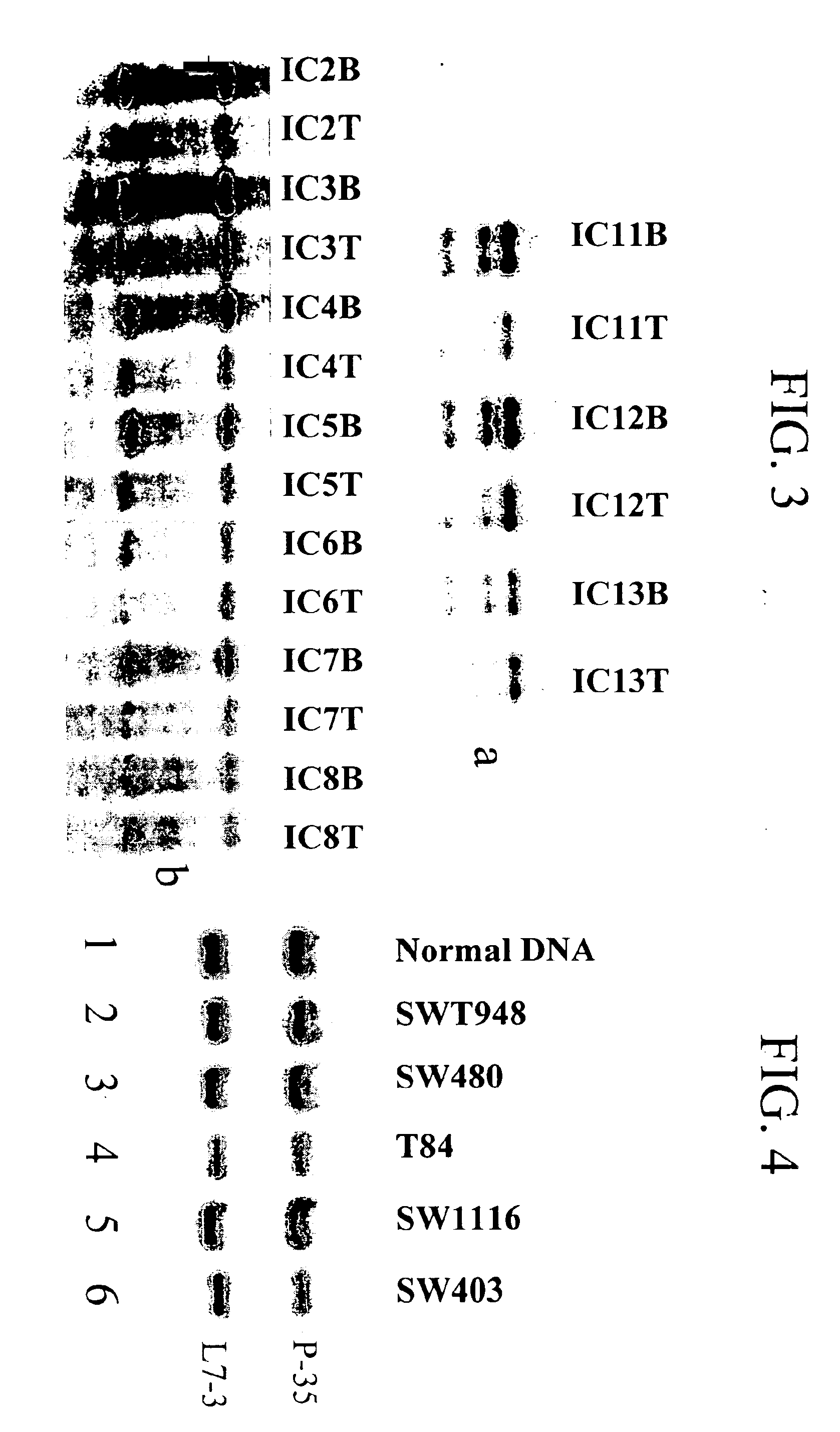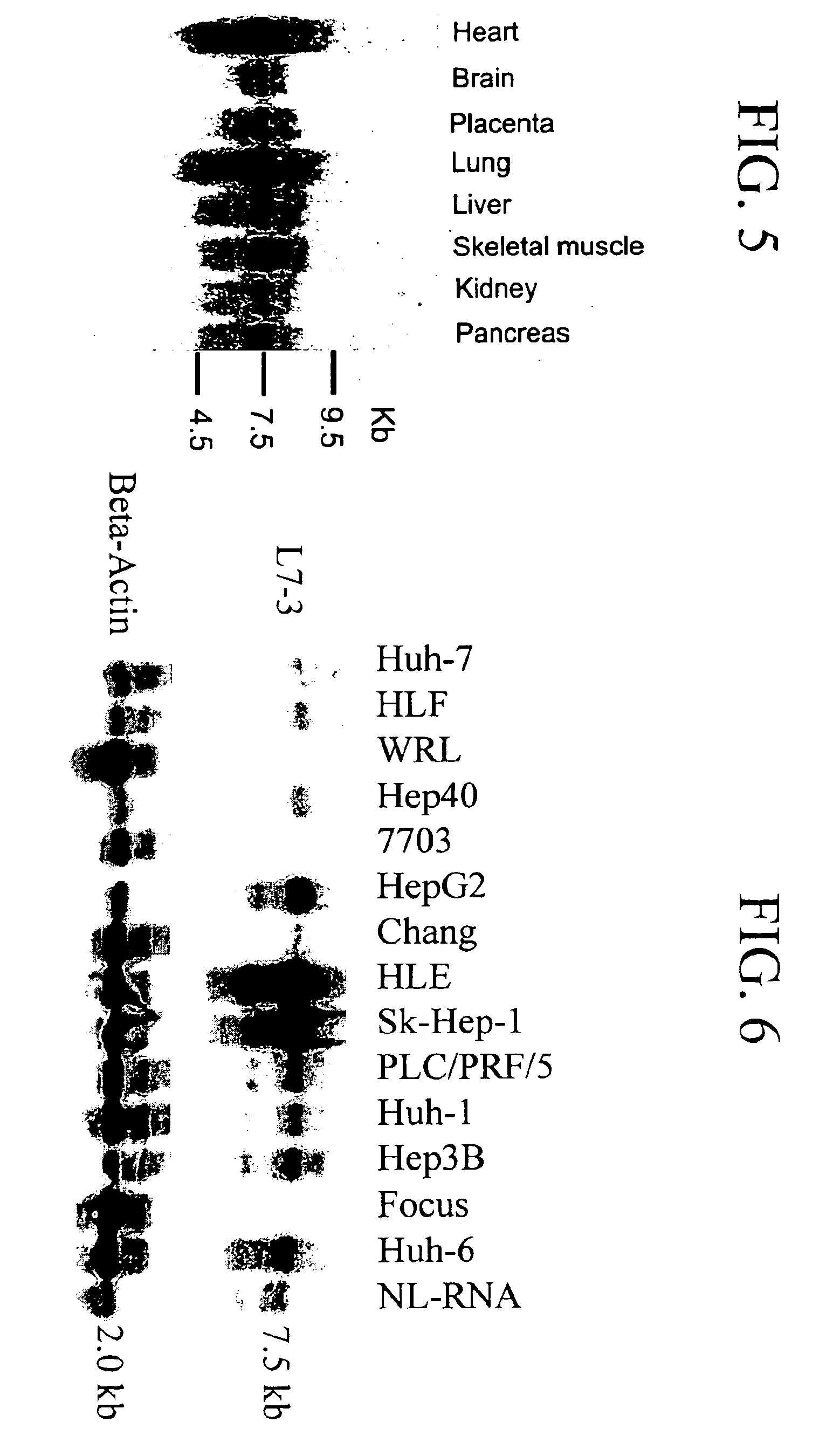DLC-1 gene deleted in cancers
a cancer and dlc1 technology, applied in the field of cloning and sequencing, can solve the problems of hampered efforts to diagnose predisposition and inability to identify the tumor suppressor genes involved in such deletions, and achieve the effect of rapid classification of patients and enhanced ability to diagnose susceptibility
- Summary
- Abstract
- Description
- Claims
- Application Information
AI Technical Summary
Benefits of technology
Problems solved by technology
Method used
Image
Examples
example 1
Detection or DLC-1 Deletion in Liver Cancer Cells by RDA
[0120]Primary HCC tumor samples, matched with surrounding non-cancerous liver tissue, were obtained as described above and analyzed by RDA. Several RDA difference products were observed after the third round of hybridization / selection as distinct bands in agarose gel. Twenty individual fragments were isolated and analyzed by Southern blot hybridization for deletions. One clone, L7-3, of 600 bp (Seq. I.D. No. 12), showed loss of heterozygosity (LOH) in the primary tumor (FIG. 1). BLAST search revealed that the L7-3 clone had homology to rat p122 RhoGAP cDNA (Homma and Emori, EMBO. J. 14:28691, 1995).
example 2
Southern Analysis
HCC Cell Lines
[0121]To determine if the L7-3 clone is represented in a region recurrently deleted in HCC, 15 primary HCC tumors and 11 HCC-derived cell lines were examined using Southern analysis as described above. The DNA was digested with BglII, and probed with L7-3 (Seq. I.D. No. 12). Seven of the fifteen primary HCC tumors (representatives are shown in FIG. 1) and 9 of the 11 HCC cell lines (FIG. 2) hid a genomic deletion of thee L7-3 clone compared to no deletions in the normal liver cells.
Primary Breast Carcinomas
[0122]Using Southern analysis as described above, primary human breast cancer and corresponding patient blood cell DNA was digested with BglII (FIG. 3a) or BamHI (FIG. 3b) and probed with full-length DLC-1 cDNA (Seq. I.D. No. 1). Genomic deletions of DLC-1 gene were detected in 7 of 15 human primary breast cancers (representatives are shown in FIG. 3). Deletions were noted if the DNA intensity of the tumor tissues exhibited at least half the intensit...
example 3
Northern Analysis
HCC Cell Lines
[0125]Considering the significant DNA sequence homology of the L7-3 clone with rat RhoGAP cDNA, its mRNA expression was examined in both normal human tissues and HCC-derived cell lines by Northern analysis as described above. Analysis of mRNA isolated from several normal human tissues, including liver, demonstrated that the L7-3 clone (Seq. I.D. No. 12) hybridized to a 7.5 kb (major) transcript and a 4.5 kb (minor) transcript (FIG. 5) that were detected in all normal tissues but not in 4(WRL, 7703, Chang and Focus) out of-14 human HCC-derived cell lines (FIG. 6).
Colorectal Carcinomas
[0126]Using Northern analysis as described above, RNA from normal and CRC cell lines was prepared and probed with the full-length DLC-1 cDNA (Seq. I.D. No. 1). In human CRC cell lines, II out of 17 (HCT-15, LS147T, DLD-1, HD29, SW1116, T84, SW1417, SW403, SW948, LS180, SW48) showed noticeably decreased or no expression of DLC-1 mRNA (FIG. 7). In this experiment, the normal ...
PUM
| Property | Measurement | Unit |
|---|---|---|
| temperature | aaaaa | aaaaa |
| concentration | aaaaa | aaaaa |
| temperature | aaaaa | aaaaa |
Abstract
Description
Claims
Application Information
 Login to View More
Login to View More - R&D
- Intellectual Property
- Life Sciences
- Materials
- Tech Scout
- Unparalleled Data Quality
- Higher Quality Content
- 60% Fewer Hallucinations
Browse by: Latest US Patents, China's latest patents, Technical Efficacy Thesaurus, Application Domain, Technology Topic, Popular Technical Reports.
© 2025 PatSnap. All rights reserved.Legal|Privacy policy|Modern Slavery Act Transparency Statement|Sitemap|About US| Contact US: help@patsnap.com



